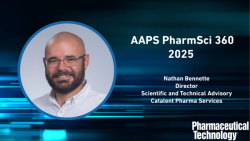
OR WAIT null SECS
- About Us
- Advertise
- Contact Us
- Editorial Info
- Editorial Advisory Board
- Do Not Sell My Personal Information
- Privacy Policy
- Terms and Conditions
© 2025 MJH Life Sciences™ , Pharmaceutical Technology - Pharma News and Development Insights. All rights reserved.
The Biosimilars Market Today And Tomorrow
Pharmaceutical Technology Europe
Last year, the global market for biological products exceeded $125 billion, accounting for 17% of the total market for pharma/biopharma products.
The full version of this biosimilars feature can be read in the August issue of our digital magazine: http://www.pharmtech.com/ptedigital0810
Last year, the global market for biological products exceeded $125 billion, accounting for 17% of the total market for pharma/biopharma products; however, its portion of the global market is expected to rise markedly in the next few years. In fact, by 2014, we estimate that the top three products in terms of global sales will be biotech medicines (Avastin, Humira, Enbrel), collectively accounting for $25.4 billion, with today's small molecule brand leaders being relegated to commodity generics. With many of the blockbuster biologics nearing patent expiry in the next 10 years in the US, including Avastin (Genentech/Roche), Enbrel (Amgen) Erbitux (Eli Lilly) and Humira (Abbott), it is easy to understand the appeal that investing in biosimilars holds. However, in spite of this potential, last year biosimilars only generated around $89 million in sales, with Sandoz's omnitrope accounting for the vast portion of those sales (33% market share), hence it is still a largely immature market. On a more positive note, growth in sales between June 2008 and June 2009 increased by a remarkable 200%.
Alan Sheppard
Europe is by far the most advanced in terms of biosimilars approvals, but despite being the only region to have passed a specific regulatory pathway for biosimilars, only a few manufacturers have launched products in Europe (Figure 1). In total, 13 biosimilars have been approved in Europe to date for somatropin, epoetin and filgrastim. Market penetration naturally varies considerably between EU countries because of differing reimbursement policies, adoption and utilisation habits, prescriber influence and pricing, with Germany accounting for the greatest market share in Europe and indeed, worldwide (Table 1). Omnitrope is the only biosimilar to have gained approval in the US market (launched by Sandoz in 2006) but with restricted indications.
Figure 1: Evolution of the biosimilars market is in early stage in most markets.
One particular factor limiting the market penetration of biosimilars is legislation, which prevents substitution of an originator product with a biosimilar. This often means that use is restricted to new patients and short-term indications. However, the opportunity for cost containment using biosimilars is significant. The three key factors that will govern success in those markets that have yet to define a regulatory pathway, including the US, will be based on patent exclusivity, clinical trails requirements, and interchangeability (and thus substitution). Overall, it is fair to assume that there will be fewer players in the biosimilars market compared with standard generics.
Table 1: Current market share value for marketed biosimilars by country in Q2 2009.
The future market landscape
The rising drugs bill — of which biotech products contribute heavily to — mean that payers must address the barriers to biosimilars access in order to control costs. The imminent patent cliff faced by many marketed biologics will shift the future growth potential of generics companies towards biotech products.
Sandoz is currently the global market leader in biosimilars sales (the only company to have more than two biosimilar products approved) with Teva and Hospira also developing a range of biosimilar products. Meanwhile, some Indian companies are using their experiences within the deregulated markets to produce dossiers and products suited for the regulated markets.
Figure 2: Competencies required for manufacturing and marketing biosimilars. Companies are developing competencies required for success in the developed markets. Generics companies may not be best placed to develop, manufacture and market biosimilars successfully.
Because of the loss of sales from blockbuster brands, certain R&D-based companies are also eyeing biosimilars as an opportunity for future growth; for instance, Merck has launched Merck Bioventures to develop biosimilars. Other major players with existing biotech capabilities are also in a strong position. The biosimilars market requires clinical promotion and this is best served by the R&D-based industry, although some generic companies are also developing the necessary skills. Figure 2 shows the competencies required for manufacturing and marketing biosimilars and highlights which companies are best placed to be successful.
Many companies have embarked on partnering and licensing deals in the area of biosimilars, but it will be those that already have in-house capabilities who will be in the best position. The cost of acquisition in this field is high and with the current limited penetration of biosimilars there is no guarantee of a return on investment in the short-to mid-term.
Forecasting biosimilar sales is complex because of the imprecise classification of a biosimilar, direct sales from manufacturer to customer, pricing policies of the originator resulting in the use of the brand in place of the biosimilar, and tendering and contract pricing. Some estimates show the market growing from $66 million in 2008 to $2.3 billion in 2015. Others see sales exceeding $5.6 billion in 2013. Whatever the forecast, there remains a $50 billion potential for biosimilars; however, the delivery of this will be dependent on legislation, substitutability and originator strategies.
Alan Sheppard is Principal, Thought Leadership, Global Generics at IMS Health.
Related Content:



